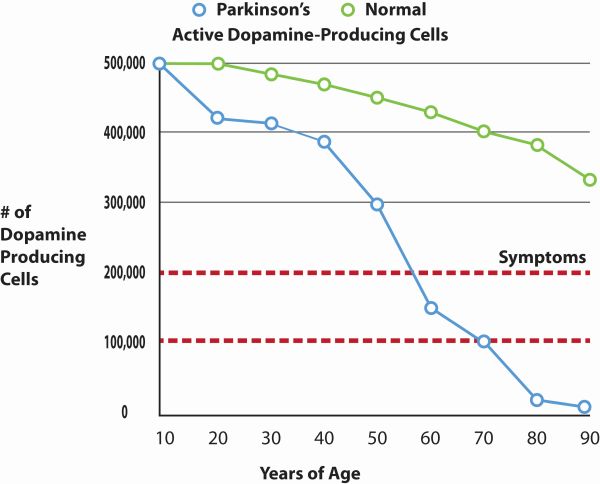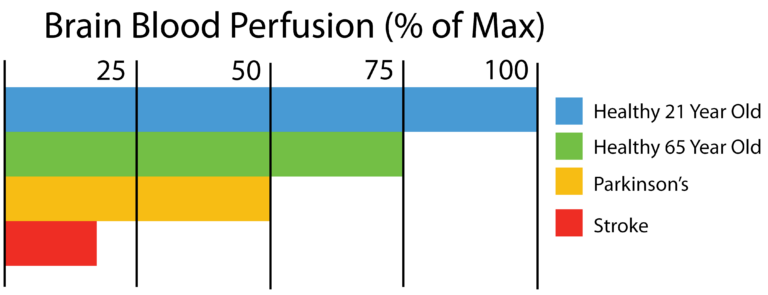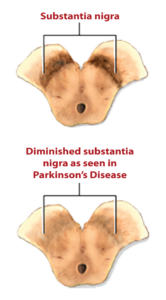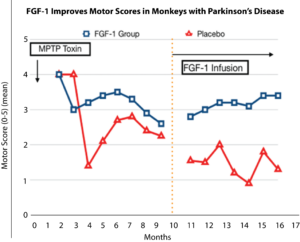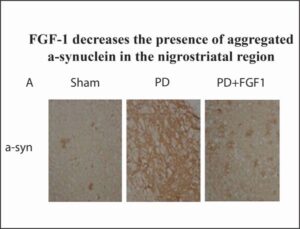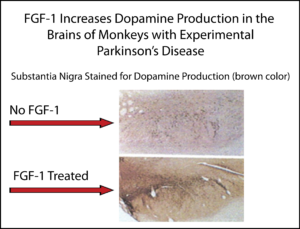
PARKINSON'S DISEASE
Our Hypothesis: Growing Blood Vessels and Nerves in the Brain Can Reverse Parkinson’s Disease
Parkinson’s disease is a neurological disease which results in the decline of the dopamine-producing neurons in the brain. When dopamine declines, a person will experience the symptoms of Parkinson’s disease. Recent research has shown that Parkinson’s patients have less blood flow to the part of the brain that has the dopamine-producing neurons. Animal tests have shown a reversal of Parkinson's symptoms with the introduction of the growth factor FGF-1. We know that FGF-1 has been shown to grow blood vessels and nerves, a process known as angiogenesis. We believe that if we can grow blood vessels and nerves in the brain where the dopamine-producing neurons reside, we should be able to reverse Parkinson’s disease.
Below is a graph comparing the normal decline in dopamine producing neurons as one ages compared to the decline in Parkinson’s patients.
The dopamine-producing neurons reside in the brain’s substantia nigra. As shown in the chart above, imaging studies have demonstrated that a healthy 65 year-old will have 75% of the blood flow to the substantia nigra when compared to a healthy 21 year-old. Parkinson’s patients have only 50% of the blood flow to the substantia nigra. As shown in the depiction of the substantia nigra, the substantia nigra will lose its brown color as the neurons die. Every neuron needs a blood vessel to bring it nourishment and to take out waste products. If there are fewer blood vessels in the subtantia nigra, the neurons will begin to die and a type of plaque composed of aggregated α-synuclein protein particles will begin to accumulate. These plaques are also toxic to the dopamine neurons and contribute to the pathology of the disease.
Research has shown that monkeys that have induced Parkinson’s disease saw a reversal of their symptoms with the introduction of FGF-1. “In previous studies conducted with monkeys, our drug [FGF-1] demonstrated a genuine disease modifying effect as it successfully regenerated new dopamine neurons in the brain, which, we believe, led to the restoration of the animal’s motor skills,” says Jack Jacobs, PhD, Zhittya Genesis Medicine’s president.
Experimental Results
1. Below is a graph that shows two sets of monkeys that had Parkinson’s induced with a MPTP toxin which caused the monkeys to have the symptoms of Parkinson's. After 9 months, one group was given FGF-1 and the motor skills of this group improved over the next 6 months.
2. The slides below show the reduction in aggregated alpha-synuclein in the nigrostriatal region in animals that received the FGF-1.
3. The image below shows the brains of the monkeys after the experiment was finished. The ones without FGF-1 show a very light discoloration which indicates a low level of dopamine-producing neurons. The monkeys treated with FGF-1 show a greater dark coloration indicative of more dopamine-producing neurons.
Watch this video from our Research Partner:
If we can grow blood vessels and nerves in the brain where the dopamine producing neurons reside, we believe that we can reverse Parkinson’s Disease. Please sign up below to get updates on trials, presentations and progress from Wund.
Research Papers and Additional Reading:
- Neurotrophic factors for the treatment of Parkinson’s disease. Sullivan AM and Toulouse A. Cytokine Growth Factor Rev 2011; 22: 157165. (Link: https://www.ncbi.nlm.nih.gov/pubmed/21689963)
- Neurotrophic factors for the treatment of Parkinson’s disease. Chiocco MJ, Harvey BK, Wang Y and Hoffer BJ. Parkinsonism Relat Disord 2007; 13 Suppl 3: S321-328. (Link: https://www.ncbi.nlm.nih.gov/pubmed/18267258 )
- The FGF family: biology, pathophysiology and therapy. Beenken A and Mohammadi M. Nat Rev Drug Discov 2009; 8: 235-253. (Link: https://www.nature.com/articles/nrd2792)
- Fibroblast growth factors enhance dopamine fiber formation from nigral grafts. Giacobini MM, Stromberg I, Almstrom S, Cao Y and Olson L. Brain Res Dev Brain Res 1993; 75: 65-73.(Link: https://www.ncbi.nlm.nih.gov/pubmed/7693370)
- Long-term intracerebral infusion of fibroblast growth factors restores motility and enhances F-DOPA uptake in parkinsonian monkeys.de Yebenes JG, Pernaute RS, Garrido JM, Rabano A, Albisua J, Rojo A, Mena MA, Ruiz PG, Jorge P, Correa C, Leenders K, Antonini A, Gunther I, Psylla M and Vontobel P. Parkinsonism Relat Disord 1998; 4: 147-158. (Link: https://www.ncbi.nlm.nih.gov/pubmed/18591105 )
- Administration of FGF-1 through transfected cells alleviates MPTP toxicity in mice. McLay RN, Freeman SM, Zadina JE. 2001.. Neurotox Res 3:249–253. (Link: https://www.ncbi.nlm.nih.gov/pubmed/15111249 )
- Fibroblast growth factor 1 attenuates 6-hydroxydopamine-induced neurotoxicity: an in vitro and in vivo investigation in experimental models of Parkinson’s disease. Wei1 X, S He, Z Wang, J Wu, J Zhang, et. al. 2014. Am J Transl Res 2014;6:664-677.(Link: https://www.ncbi.nlm.nih.gov/pmc/articles/PMC4297335/ )
- Human Hippocampal Neurogenesis Persists throughout Aging. Boldrini M, Fulmore CA, Tartt AN, et al. 2018. Cell Stem Cell 22:589–599. (Link: https://www.ncbi.nlm.nih.gov/pubmed/29625071 )

